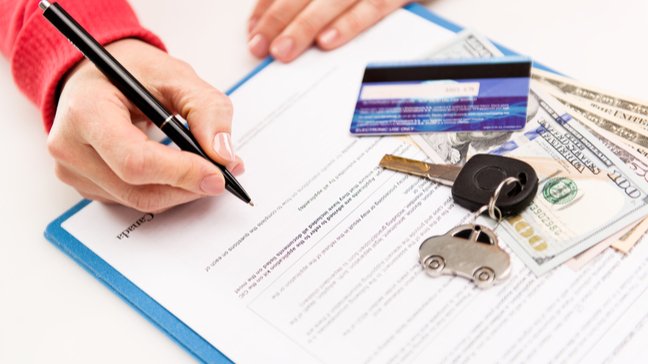Thinking about leasing a car? You’re not alone; about a quarter of all new car shoppers end up going with a lease for various reasons, such as worry-free maintenance and the affordability of a brand-new car.
But one key drawback to car leases is that most leasing companies will require you to purchase pretty robust insurance. State minimums aren’t nearly enough; you’ll typically need what’s known as “full coverage” throughout the lifespan of your lease.
Let’s cover everything you need to know about insurance for leased cars, so you can officially decide if leasing is the right move for you.
Insurance Requirements for a Leased Car
Leased cars typically require what’s known as “full coverage” — a mix of liability, collision, and comprehensive. Plus, leasing companies typically require higher liability limits than state minimums as well as lower deductibles across the board.
Here’s what leasing companies typically require:
Liability (Higher Than State Minimums)
In 49 U.S. states plus D.C. (funny look directed at New Hampshire), drivers are legally required to carry a certain amount of liability coverage at all times. Georgia’s rules, for example, are 25/50/25, meaning $25k in bodily injury liability per person (BIL), $50k in BIL per accident, and $25k in property damage liability.
However, because liability coverage protects the owner of the vehicle from lawsuits, many leasing companies require you to beef up your liability coverage. That especially applies to bodily injury liability limits, since personal injury lawsuits can get pricey.
Kia, for example, requires leased vehicles to be covered by 100/300/50 insurance — multiples higher than many state minimums.
Uninsured and Underinsured Motorist Coverage
Another required form of insurance in many states is uninsured and underinsured motorist protection. This form of coverage protects you from motorists who don’t have enough insurance to cover what they legally owe you (or the dealer) after an accident.
Currently, 22 states require motorists to carry underinsured and uninsured motorist coverage. If you live in one of them, it’s possible that your leasing company will require higher than state minimum coverage.
Even if you live outside of those states, it’s still possible that your leasing company will require some UIM coverage since it fills a gap left by other forms.
Collision Coverage
Pretty much 100% of dealers and manufacturers require collision coverage on their leased vehicles.
As the name implies, collision protects your car if you’re involved in an accident, regardless of who’s at fault. It can also cover hit-and-runs. Needless to say, collision coverage fills a big, big insurance gap and helps leasing agents sleep better at night.
Comprehensive Coverage
In addition to collision insurance, virtually all leasing companies require comprehensive coverage to protect their property. Comprehensive coverage applies to any damage the car sustains outside of the context of an accident.
Comprehensive coverage typically covers theft, vandalism, natural disasters (floods, hail, tornadoes), and falling objects (trees, pianos, etc.).
A buddy of mine once had a mystery water balloon crash through his Mercedes windshield and fry his center console. Luckily, that’s precisely the kind of situation comprehensive covers, and why leasing companies require it.
Read more: Comprehensive vs. Collision Car Insurance
Gap Insurance
The last form of insurance typically required by leasing companies is gap insurance.
Although gap is technically an acronym for Guaranteed Asset Protection, the image of it filling a “gap” actually works pretty well. The gap in question is the difference between the lease payoff amount and the actual cash value (ACV) of the car.
As a rudimentary example, imagine you lease a $35,000 car, and a year in, you wreck it. So far, you’ve made $5,000 in lease payments, but the insurance company is only paying out $20,000. Who eats that $10,000 in value?
The dealer says you do, but nobody wants to sue anybody and lose a client for life. For that reason, most leasing companies just purchase gap insurance for you, and bake the cost into the terms of the lease. If you’re wondering why this is the only form of insurance that a leasing company buys for you, it’s because gap insurance is typically a one-time fee, not a recurring cost that can fluctuate.
Even if your leasing company doesn’t require gap insurance, it might be a good idea if your lease terms could leave you liable for a large gap. “Gap wideners” include:
- Leasing an expensive car
- Leasing a car that depreciates quickly (sports, luxury, etc.)
- Making a small down payment
It’s totally normal to have a frank conversation with your dealer or leasing company to ask their opinion on gap insurance. They may not require it, but strongly recommend it based on your specific lease terms. Plus, they may be able to offer you a discount with their preferred gap insurance provider.
High Liability Limits and Low Deductibles Across the Board
Lastly, it’s worth noting that leasing companies often have minimum limits and maximum deductibles for each type of insurance where that applies.
For example, General Motors (which includes Chevrolet, Buick, GMC, and Cadillac) requires a collision and comprehensive deductible of $1,000 or lower on all of their leased vehicles. Mercedes’ is higher, at $2,500, presumably because they cater to a clientele that can probably afford the out-of-pocket expense.
Tesla requires 100/300/50 for liability, which is pretty standard, and a maximum deductible of $2,500 just like Mercedes-Benz. As for collision and comprehensive limits, you need enough “physical damage insurance” to cover “the full value of the vehicle.” I think what they’re hinting at is: buy gap insurance, homie.
Why Do Leased Cars Require Additional Insurance?

The delta between owned, financed, and leased car insurance all comes down to ownership. Whoever legally owns the car gets to dictate how much insurance coverage is required.
Owned cars have low insurance requirements because you’re not required to protect your own property.
To put it bluntly, neither the state nor the dealership really cares if you wreck your own stuff. You’ll notice that the only type of insurance states require, liability, is designed to protect others in the case of an at-fault accident. Insurance to protect your own stuff is optional, but not required.
Leased and financed cars have high insurance requirements because they belong to someone else.
Leased cars (and oftentimes financed cars, as well) have much higher insurance requirements because you’re effectively renting someone else’s property. Whoever owns the car gets to dictate how much coverage you need to purchase to protect their stuff.
Imagine a world where leases didn’t require collision or comprehensive coverage. Tomorrow, someone could lease a $250,000 S65 AMG, wrap it around a tree, and simply dodge the Mercedes dealer’s calls. Sure, the dealer could sue them, but they’d never recoup anything even close to the car’s original value.
Higher insurance for leased cars isn’t just about protecting the value of the car, either. If you cause an accident, the victim may attempt to sue the owner of the car — that’s not you, that’s the dealer.
Read more: Car Insurance Coverage Estimator – How Much Should Your Car Insurance Cost?
Cost of Insurance for a Leased Car

The premiums on your, well, premiums for leased car insurance will greatly vary based upon your age, sex, location, driving history, the value of the car, requirements of the dealer, and literally thousands of other variables.
But here are some ballpark upper estimates to give you a rough idea:
- Increasing your liability limits to above state minimums: + $100 per year
- Collision: + $600 per year
- Comprehensive: + $200 per year
- Gap insurance: + $500 once, or $30 per month
- Total increase over state minimums: ~$930 per year
Again, don’t hold me to that, but that should give you a rough enough idea to plan ahead. You can also go ahead and collect insurance quotes online for a more accurate figure.
Read more: At What Age Do Car Insurance Rates Go Down?
Remember, Car Insurance for Leases Won’t Cover Everything
While it’s great to have extra coverage if you can afford it, keep in mind that even your beefed-up lease coverage doesn’t quite cover everything.
Here are a few examples of costs you may still incur while leasing your vehicle:
Your Deductibles
Naturally, you’ll still be on the hook for your deductibles in the event you file a claim with your insurance company. When it comes to insuring leased vehicles, if you’re ever left wondering, “Will I pay or will the dealer pay?”, the answer is almost always you.
The Credit Card Test®
Ah, the dreaded Credit Card Test®. Lots of dealers do it, but I assume Mercedes are the ones who finally trademarked it since they boldly list it on their lease return page.
Here’s how it works: when you return a leased vehicle, the dealer will carefully inspect the interior and exterior for cuts, nicks, scratches, bruises, and blemishes. Anything that can’t be hidden by a standard-sized credit card, they’ll charge you for.
The Credit Card Test® is the root canal of car leasing: expensive, unpleasant, and if you know it’s coming, it ruins your work. Plus, lessees are often shocked to discover that the dealer charges to repaint a single body panel of a luxury car can exceed $1,000.
All the Other Costs of Car Ownership
In addition to your down payment, monthly lease rate, and insurance quote, have you considered the other costs of car ownership?
- Licensing, registration, and taxes
- Leasing fees (early termination, disposition fees, etc.)
- Fuel or electricity
- Parking
- Maintenance and repairs not covered by your lease agreement
And more. Yep, car ownership is expensive. Leased cars have fewer running costs since the dealer will take care of most repairs and maintenance, but I’d still recommend that you plan to spend 150% of your monthly lease rate on total expenses per month. For financed or owned cars, I typically say 200%, just to be safe.
At this Rate, Should You Even Lease a Car At All?
As you can tell, I’m not the biggest fan of auto leasing for a few reasons. Namely, it’s actually more expensive to lease a new car than to finance and keep its gently pre-owned equivalent. Plus, with a financed car, you never have to wonder whether you’ve exceeded some dealer’s wear-and-tear limits.
While leasing versus buying doesn’t make financial sense, sometimes you just want a brand-new car for a few years. I get that; there’s an emotional quality to car ownership, and sometimes you just want something fresh from the factory and don’t mind paying the premium.
If that’s you, go for it.
Read more: Is It Better to Buy or Lease a New Car?
Summary
You’ll need to purchase extra insurance coverage for leased cars because the car’s legal owners will want you to drive around well-covered, reducing their financial risk.
Leasing companies typically require “full coverage,” including liability, collision, and comprehensive coverage: all with high limits and low deductibles.
As a result, if you’re making the leap from state minimum insurance to lease minimum insurance, you should conservatively expect to pay around $900 annually for the extra coverage.
